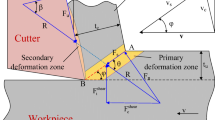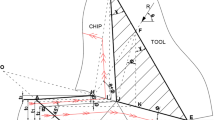Abstract
The slip-line field methods are widely used in solving cutting problem; however, most of which were focused on the pressure-independent materials. In this work, a new slip-line field model for orthogonal cutting of pressure sensitive materials is developed. Analytical characterization for orthogonal cutting process is obtained, which can give the explicit expressions for the shear angle, cutting force, and chip thickness in terms of the tool geometry, the friction coefficients on the tool flat, and the internal friction angle of the materials. To investigate the effect of the material and cutting parameters on cutting process, the finite element simulation is performed as well. The comparisons between the shear angle and cutting force predicted by the theoretical model with those obtained from finite element model simulation are made. The good agreement of the predicted results with the numerical results clearly reveals that the proposed slip-line field model can satisfactorily characterize the orthogonal cutting behavior of the pressure sensitive materials. Further analysis has demonstrated that the pressure sensitivity of materials has a significant influence on cutting process.
Similar content being viewed by others
References
Atkins AG (2009) The science and engineering of cutting: the mechanics and processes of separating, scratching and puncturing biomaterials, metals and non-metals. Butterworth-Heinemann, Boston
Shaw MC (2005) Metal cutting principles, 2nd edn. Oxford University Press, Oxford
Oxley PLB (1989) Mechanics of machining: an analytical approach to assessing machinability. Wiley, New York
Piispanen V (1948) Theory of formation of metal chips. J Appl Phys 19:876–881
Merchant ME (1945) Mechanics of the metal cutting process. I: orthogonal cutting and the type 2 chip. J Appl Phys 16:267–275
Merchant ME (1945) Mechanics of the metal cutting process II: plasticity conditions in orthogonal cutting. J Appl Phys 16:318–324
Atkins AG (2003) Modelling metal cutting using modern ductile fracture mechanics quantitative explanations for some long standing problems. Int J Mech Sci 45:373–396
Atkins AG (2005) Toughness and cutting: a new way of simultaneously determining ductile fracture toughness and strength. Eng Fract Mech 72:849–886
Subbiah S, Melkote SN (2007) Evaluation of Atkins’ model of ductile machining including the material separation component. J Mater Process Technol 182:398–404
Lee EH, Shaffer BW (1951) The theory of plasticity applied to a problem of machining. Trans ASME: J Appl Mech 73:405–413
Fang N, Jawahir IS, Oxley PLB (2001) A universal slip-line model with non-unique solutions for machining with curled chip formation and a restricted contact tool. Int J Mech Sci 43:557–580
Fang N, Jawahir IS (2001) A new methodology for determining the stress state of the plastic region in machining with restricted contact tools. Int J Mech Sci 43:1747–1770
Fang N, Jawahir IS (2002) Analytical predictions and experimental validation of cutting force ratio, chip thickness, and chip back-flow angle in restricted contact machining using the universal slip-line model. Int J Mach Tools Manuf 42:681–694
Oxley PLB, Hstings WF (1977) Predicting the strain-rate in the zone of intense shear in which the chip is formed in machining from the dynamic flow stress properties of the work material and the cutting conditions. Proc R Soc London A 356:395–410
Karpal Y, Özel T (2008) Analytical and thermal modeling of high-speed machining with chamfered tools. Trans ASME: J Manuf Sci Eng 130:011001
Karpal Y, Özel T (2008) Mechanics of high speed cutting with curvilinear edge tools. Int J Mach Tools Manuf 48:195–208
Bakkal M, Shih AJ, Scattergood RO (2004) Chip formation, cutting forces, and tool wear in turning of Zr-based bulk metallic glass. Int J Mach Tools Manuf 44:915–925
Bakkal M, Shih AJ, McSpadden SB, Scattergood RO (2005) Thrust force, torque, and tool wear in drilling the bulk metallic glass. Int J Mach Tools Manuf 45:863–872
Jiang MQ, Dai LH (2009) Formation mechanism of lamellar chips during machining of bulk metallic glass. Acta Mater 57:2730–2738
Jeong HY, Li XW, Yee AF, Pan J (1994) Slip lines in front of a round notch tip in a pressure-sensitive material. Mech Mater 19:29–38
Yu GS, Lin JG, Mo M, Wang XF, Wang FH, Wen CE (2007) Effect of relaxation on pressure sensitivity index in a Zr-based metallic glass. Mater Sci Eng A 460:58–62
Hill R (1950) The mathematical theory of plasticity. Clarendon, Carolina, pp 294–300
Movahhedy M, Gadala MS, Altintas Y (2000) Simulation of the orthogonal metal cutting process using an arbitrary Lagrangian-Eulerian finite-element method. J Mater Process Technol 103:267–275
Adetoro OB, Wen PH (2010) Prediction of mechanistic cutting force coefficients using ALE formulation. Int J Adv Manuf Technol 46:79–90
Mamalis AG, Kundr J, Markopoulos A, Manolakos DE (2008) On the finite element modeling of high speed hard turning. Int J Adv Manuf Technol 38:441–446
Paulo DJ, Maranhao C, Jackson MJ, Cabral G, Gracio J (2008) FEM analysis in high speed machining of aluminium alloy (Al7075-0) using polycrystalline diamond (PCD) and cemented carbide (K10) cutting tools. Int J Adv Manuf Technol 39:1093–1100
Author information
Authors and Affiliations
Corresponding author
Rights and permissions
About this article
Cite this article
Ye, G.G., Xue, S.F., Tong, X.H. et al. Slip-line field modeling of orthogonal machining pressure sensitive materials. Int J Adv Manuf Technol 58, 907–914 (2012). https://doi.org/10.1007/s00170-011-3459-3
Received:
Accepted:
Published:
Issue Date:
DOI: https://doi.org/10.1007/s00170-011-3459-3




